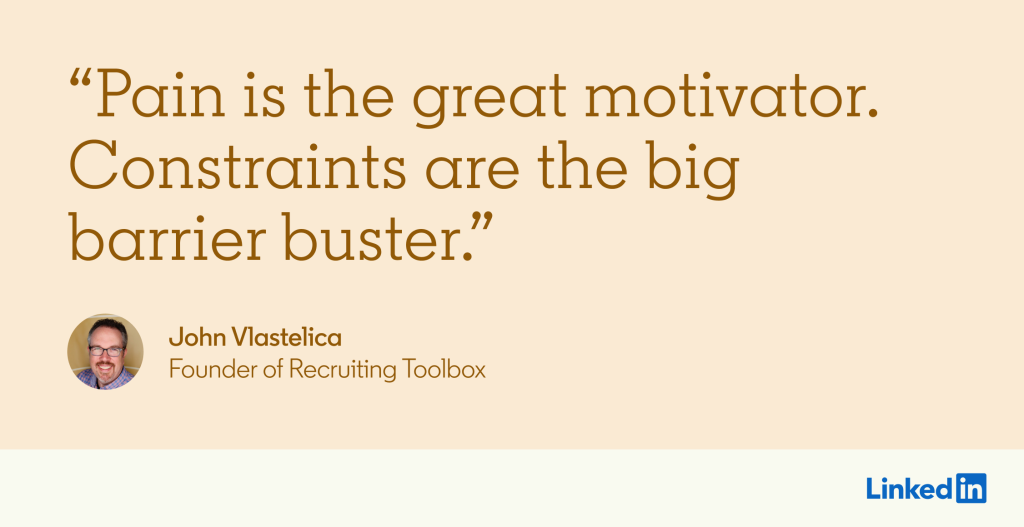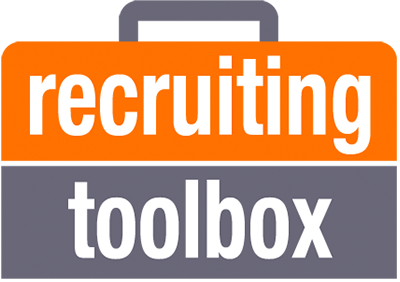Recruiting Toolbox Blog
Don’t Waste Constraints: How Challenging Times Can Drive Change
This blog post first appeared on LinkedIn Talent blog.

Whether the economy is good or bad, it’s rare that talent acquisition teams are fully resourced. Even when the economy was stronger and central TA roles such as TA enablement, program leaders, analysts, and branding roles were funded, the to-do list still exceeded the resources available for most corporate recruiting teams.
As a former corporate TA leader who talks with heads of TA for a living, I can relate to the challenges most of us are facing today. Most of us are working inside very lean people teams.
I have written about some things we can do as talent leaders when we’re stretched too thin. I have shared ideas on how to prioritize, what things to outsource, and how to get the business to fund some of our resource gaps. But in the recent economy, many TA teams lost central resources as soon as hiring volumes decreased from their peaks.
Many of our clients are dealing with serious constraints — no teams to run big initiatives, recruiters taking on side-projects that would normally have a full-time person dedicated to them, more junior people getting stretch assignments into bigger roles, and overall TA budgets shrinking.
Resource constraints can frustrate, but they can also present opportunities
Yes, it sucks to have fewer resources than what you need to do your best work.
But sometimes constraints lead to innovation. It’s often because you don’t have enough resources that you look to streamline processes, deprioritize that low ROI work, automate the admin stuff, and experiment with new strategies and approaches. This is true no matter what function you’re in — finance, HR, engineering, whatever — constraints can nudge you to try new tools, new ideas, new alliances (maybe if we pooled our resources we could get this done).
If I’m being transparent, some things that I’m really proud of in my career as a practitioner — like building and coleading Amazon’s Bar Raisers program and building event-based sourcing programs back in Amazon’s formative years — might not have been possible if I’d had all the resources I needed to do my job as a TA leader well. It was because I was so constrained (or my hiring managers were so constrained) that I was able to get things built and adopted.
Webster’s defines innovate as “to make changes: do something in a new way.” Our resource constraints were a forcing function to try new things. To innovate.
Remember when we’d build out paper offer letter packets and courier or FedEx them to candidates? Now most of us use DocuSign. And COVID-19 forced an acceleration of video-based interviews. Challenging labor markets will surely hasten the use of AI. Limited HR budgets will certainly shape, again, what we expect of our people managers. (Side note: I’m super-worried about how much we push to middle managers inside companies. Most are overwhelmed with all of the self-service initiatives, training, and people processes and forms we push at them.)
What are your opportunities? How can you leverage some of these constraints to effect change?
I don’t think we, as leaders of people functions, are always great at driving change. Many smart TA leaders, for example, are great at coming up with the ideas — the what and the how — but often fall short at selling the ideas, at driving adoption across their orgs.
If you, like me, have struggled in the past to get buy-in for new strategies and processes and training, you may benefit from your resource constraints, from your limited budget. It’s amazing to me how many scrappy startups we’ve consulted with who can sometimes get more done (or get things done faster) than much bigger people competitors because they’re just not able to form a committee or hire an outside firm or spend six months planning.
They just have to find a way — and they often do.
Pain is the great motivator. Constraints are the big barrier buster. And if you’re an effective leader who can shine the light on the pain and show that option A isn’t realistic given the lack of resources, it’s much easier to sell option B or C.
I’m not suggesting scrappy, half-assed is better. “Ready, aim, fire” is still generally better than “ready, fire, aim.” :) But I’ve seen some incredibly resource-constrained teams do 3x the work of properly resourced teams.
Real-life examples of how scrappy teams can use constraints to launch new approaches
Example 1: A company wanted to recruit from universities but didn’t have the TA team to go out on campus, didn’t have hiring manager engagement to travel to schools and build long-term relationships with university professors, and couldn’t afford to build out great intern programs with structure and meaty projects.
So, they got scrappy.
They skipped on campus events and just direct-sourced upcoming grads from their people competitors’ intern programs. They also hired by soliciting referrals from different alumni cohorts at their own companies. They built their brand and hired people by hosting events and tours at their headquarters for the local university clubs that attracted their target grads. There was no campus recruiting/university relations TA managers or recruiting team. They couldn’t do big scale.
But they could do scrappy and fast.
P.S. Once they showed the business the value of early-career talent, they were able to fund bigger investments in university programs.
Example 2: I was leading tech recruiting at a company and we just didn’t have enough interviewers to meet hiring manager demands for hires. Our traditional model: Bring in a candidate and have them meet with four to six people from the hiring manager’s team, for one open req, and if the team wasn’t interested but the candidate was good, bring them back to meet with another team, for another req.
This wasn’t scaling. Yes, we worked in parallel to grow our interviewers through interview training and mentoring, but the key was moving away from a req-based model to more of a pipeline model with batch interview days (I described this in a previous Talent Connect presentation as No. 6 of nine ways to be more strategic).
I would have loved to move to this model earlier as it created more efficient scheduling, allowed us to calibrate our interviewers more effectively, and increased our overall interview-to-offer ratio, all because we could have multiple team interviewers talk to the same candidate on the same day. But, honestly, I wasn’t able to sell this idea until we ran into serious interviewer capacity constraints.
Example 3: This one might seem simple, but it was a game changer. Early in my career as a recruiter, I moved from a mature division of a big company to a startup division of the same company. The mature company had a process where we scheduled (and by we, I mean me) live debrief meetings for all of the interviewers to come together and discuss a candidate, usually two to three days after the candidate was onsite for their interviewers.
The new division I worked for was way too lean relative to our hiring goals, and I didn’t have time to chase people to get them into another meeting. And their schedules were nuts. Because of scheduling and capacity issues, we moved to same-day debriefs — always at the same time, always in the same conference room, always with the same structured format.
So, if you had an interview on Tuesday, you knew you also had a 10-to-20-minute debrief to attend at 4 p.m. Once we got our execs to role-model this, everyone else knew they had to show up, without being chased.
But it wasn’t my incredible influencing skills that led to this more efficient process. It was just not an option to chase people (who had no admin support) and set up one-off debriefs for four or five interviewers, at times that would work for each person, and do it all in a timely fashion. By the way, this constraint allowed me to create a culture — not just a process — of same-day hiring decisions, which later in my career led me to same-day offers, at scale.
What are you hoping to change?
So, my question for you is this: What have you been hoping to change in your org? Is now the time to give it a try? Can you actually benefit from some frustrating constraints?
Don’t miss your window. Don’t waste your constraints. Now may just be the time to show the business how their talent pain can be solved with change and how a new approach is the best — and maybe only — way forward.
Do you have examples of innovative things you’ve done because of constraints? I’ll share this article on LinkedIn, and I’d love to hear your examples.
John Vlastelica is a former corporate recruiting leader turned consultant. He and his team at Recruiting Toolbox are hired by world-class companies to train hiring managers and recruiters and help raise the bar on who they hire and how they hire. If you’re seeking more best practices, check out the free resources for recruiters at TalentAdvisor.com, on recruiting from underrepresented groups at WidenTheAperture.com, and for recruiting leaders at RecruitingLeadership.com.
© Recruiting Toolbox, Inc.
No duplication or re-posting without express written permission of Recruiting Toolbox, Inc. - contact us at www.RecruitingToolbox.com/
